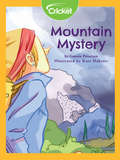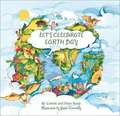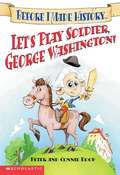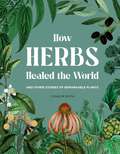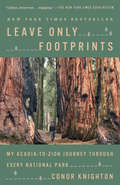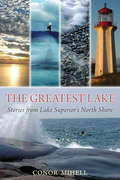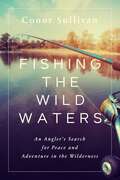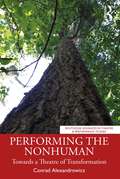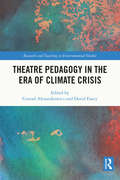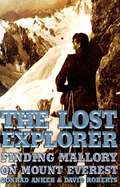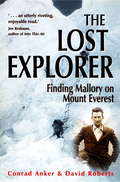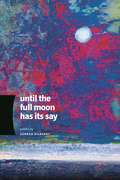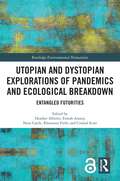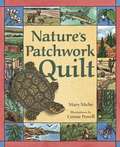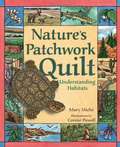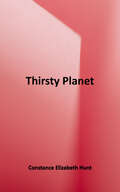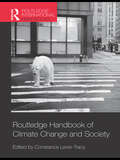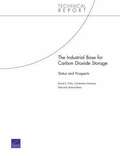- Table View
- List View
Mountain Mystery
by Connie PettersenLaura and her cousin Cassie are on a day hike when they get caught in a rainstorm and a mysterious stranger comes to their aid...
Let's Celebrate Earth Day
by Peter Roop Connie RoopA well-rounded introduction to Earth Day for young readers in a question- and-answer format. Important facts about the state of our earth are interspersed throughout, but an overall positive tone leaves readers feeling encouraged, not discouraged. Another great book in the "Let's Celebrate..". series!
Let's Play Soldier, George Washington! (Before I Made History)
by Peter Roop Connie RoopWhat you might not know is that: General Washington led our American army to victory in the Revolutionary War. President Washington was our first President. George Washington had no children of his own. George Washington fought a war so Americans could be free. We celebrate George Washington's birthday in February on Presidents' Day. But did you know George Washington really had two birthdays? George Washington's face is on every dollar bill.
How Herbs Healed the World: And Other Stories of Remarkable Plants
by Connor Smith'The writing shines when recounting the stories behind these herbs, offering a blend of history and botanical fascination' - RHS, The GardenHerbs are wonderful things. Without them so much would not be possible. With the advance of science over the last two hundred years these once mystical plants have changed and saved countless lives, vastly improving our standard of living while providing us all with a much richer, healthier diet. Today, we take for granted a world full oflife-saving drugs, luxury cosmetics and exotic foods.This fascinating book will tell this story: revealing how poisons once used by the ancient Romans such as Deadly Nightshade are now being used in modern medicine or how the herbs used by indigenous people around the world have provided remedies for countless illnesses. It will explore the myths and legends behind herbs such as the infamous Mandrake and how herbs such as Yarrow are still being used to treat wounds today, just as they were thousands of years ago; and it will show how exotic herbs from across the globe have enriched our livesand delve into the origins of the culinary herbs that everyone knows and loves.Seventy-five herbs have been carefully chosen to tell the story of how they have each changed our world, looking back at their origins and what was once believed, while comparing this with the modern day uses and the scientific value of these plants enabling the reader to understand and appreciate their importance.Each double page spread will provide both historic and modern illustrations of each herb alongside captivating accounts of their historical and modern day uses including supplementary botanical and horticultural information for each.
How Herbs Healed the World: And Other Stories of Remarkable Plants
by Connor Smith'The writing shines when recounting the stories behind these herbs, offering a blend of history and botanical fascination' - RHS, The GardenHerbs are wonderful things. Without them so much would not be possible. With the advance of science over the last two hundred years these once mystical plants have changed and saved countless lives, vastly improving our standard of living while providing us all with a much richer, healthier diet. Today, we take for granted a world full oflife-saving drugs, luxury cosmetics and exotic foods.This fascinating book will tell this story: revealing how poisons once used by the ancient Romans such as Deadly Nightshade are now being used in modern medicine or how the herbs used by indigenous people around the world have provided remedies for countless illnesses. It will explore the myths and legends behind herbs such as the infamous Mandrake and how herbs such as Yarrow are still being used to treat wounds today, just as they were thousands of years ago; and it will show how exotic herbs from across the globe have enriched our livesand delve into the origins of the culinary herbs that everyone knows and loves.Seventy-five herbs have been carefully chosen to tell the story of how they have each changed our world, looking back at their origins and what was once believed, while comparing this with the modern day uses and the scientific value of these plants enabling the reader to understand and appreciate their importance.Each double page spread will provide both historic and modern illustrations of each herb alongside captivating accounts of their historical and modern day uses including supplementary botanical and horticultural information for each.
Leave Only Footprints: My Acadia-to-Zion Journey Through Every National Park
by Conor Knighton<P><P>From CBS Sunday Morning correspondent Conor Knighton, a behind-the-scenery look at his year traveling to each of America's National Parks, discovering the most beautiful places and most interesting people our country has to offerWhen Conor Knighton set off to explore America's "best idea," he worried the whole thing could end up being his worst idea. <P><P>A broken engagement and a broken heart had left him longing for a change of scenery, but the plan he'd cooked up in response had gone a bit overboard in that department: Over the course of a single year, Knighton would visit every national park in the country, from Acadia to Zion. In Leave Only Footprints, Knighton shares informative and entertaining dispatches from what turned out to be the road trip of a lifetime. Whether he's waking up early for a naked scrub in a historic bathhouse in Arkansas or staying up late to stargaze along our loneliest highway in Nevada, Knighton weaves together the type of stories you're not likely to find in any guidebook. <P><P>Through his unique lens, America the Beautiful becomes America the Captivating, the Hilarious, and the Inspiring. Along the way, he identifies the threads that tie these wildly different places together—and that tie us to nature—and reveals how his trip ended up changing his views on everything from God and love to politics and technology. Filled with fascinating tidbits about our parks' past and reflections on their fragile future, this book is both a celebration of and a passionate case for the natural wonders that all Americans share. <P><P><b>A New York Times Bestseller</b>
The Greatest Lake: Stories from Lake Superior’s North Shore
by Conor MihellExplore the connection between people and places on the rugged shore of Lake Superior, the world’s largest freshwater lake. Conor Mihell offers a compelling image of Lake Superior’s Canadian shore through colourful personality sketches, adventure stories, and environmental accounts. Admire the kitschy decor of lighthouse cottager Maureen Robertson, a 76-year-old who spends six months of the year alone on a remote island; enter the debate over a controversial aggregate quarry in Wawa, Ontario; and learn how the author’s love affair with the world’s largest freshwater lake began on quests for a near-mystical, glacier-dropped monolith.Mihell’s stories build on Lake Superior’s rich and varied history and support its critical place in Canadian culture. Since the beginning, Lake Superior has been revered for its God-like qualities of power, unpredictability, and a seemingly endless expanse of life-sustaining freshwater. The lake’s rugged yet fragile nature and hardscrabble characters and outpost communities define rural northwestern Canada. Experience it for yourself in this first collection of stories by one of the region’s most acclaimed journalists.
State of the World 2014: Governing for Sustainability (State of the World)
by David W. Orr The Worldwatch Institute Michael Renner Tom Prugh Conor Seyle Matthew Wilburn KingCitizens expect their governments to lead on sustainability. But from largely disappointing international conferences like Rio II to the U.S.'s failure to pass meaningful climate legislation, governments' progress has been lackluster. That's not to say leadership is absent; it just often comes from the bottom up rather than the top down. Action--on climate, species loss, inequity, and other sustainability crises--is being driven by local, people's, women's, and grassroots movements around the world, often in opposition to the agendas pursued by governments and big corporations. These diverse efforts are the subject of the latest volume in the Worldwatch Institute's highly regarded State of the World series. The 2014 edition, marking the Institute's 40th anniversary, examines both barriers to responsible political and economic governance as well as gridlock-shattering new ideas. The authors analyze a variety of trends and proposals, including regional and local climate initiatives, the rise of benefit corporations and worker-owned firms, the need for energy democracy, the Internet's impact on sustainability, and the importance of eco-literacy. A consistent thread throughout the book is that informed and engaged citizens are key to better governance. The book is a clear-eyed yet ultimately optimistic assessment of citizens' ability to govern for sustainability. By highlighting both obstacles and opportunities, State of the World 2014 shows how to effect change within and beyond the halls of government. This volume will be especially useful for policymakers, environmental nonprofits, students of environmental studies, sustainability, or economics--and citizens looking to jumpstart significant change around the world.
Fishing the Wild Waters: An Angler's Search for Peace and Adventure in the Wilderness
by Conor SullivanFrom the azure waters of Hawaii to the pristine streams in Alaska to the craggy New England coast, a devoted angler reveals the agony and ectasy of fishing.Fishing the Wild Waters invites us to traverse America and visit three distant and distinct dream destinations for any serious angler—and anyone who aspires to someday become one. Sullivan's marvelous debut illuminates the often profound nature of fishing as a vehicle that connects those who practice it with reverence to a world beyond the one humans created. As we travel along with Sullivan, he reveals what goes into the pursuit of select fish in the region with humor and personal stories as well as deep knowledge. Hawaii, Alaska and New England are some of the last frontiers of fishing in America. They are full of danger, big fish, and extraordinary adventure. To fish these places is to reach back and stand alongside the First Nations of fishermen—our ancestors who lived there for thousands of years before us—as well as those early Americans who built this country using species like cod as their currency. These cultural and fishing outposts will tell us something if we can just be quiet and listen. To hear that message requires an intrinsic respect for these ancient fishing grounds and our connection to them. This mindset is in lock-step with a growing movement of anglers who fish these wildest of waters as a way to turn down the noise of modern living and tune into their fundamental, hands-on relationship with the sea, finding not only the solace, but the sustenance the fish provides to those who take the time to learn its lessons. Plus, filling a freezer with the world&’s healthiest protein just feels right. By turns funny, thrilling, and lyric, Fishing the Wild Waters celebrates the these special places where each fisherman can pull back the curtain, connect to the sea, and gaze into their own soul – the soul of a fisherman.
Performing the Nonhuman: Towards a Theatre of Transformation (ISSN)
by Conrad AlexandrowiczThis book radically reimagines theatre/performance pedagogy and dramaturgy in response to the accelerating climate crisis.This text is founded upon the principle that the theatre is the most anthropocentric of all the arts: the means of its representation, the human figure, is identical with its conventional object, the human narrative, broadly considered. In order to respond ethically to the climate crisis, it must expand its range to include performing as/in response to the nonhuman. Conrad Alexandrowicz concisely explores theoretical approaches to the other‑than‑human, found in the work of, among others, Jane Bennett, Timothy Morton, Rosi Braidotti, and Cary Wolfe. The implications of this move are far‑reaching and commence with displacing realism from its traditional position of dominance. The practices of 20th century physical theatre visionaries such as Tadeusz Kantor, Jacques Lecoq, and Jerzy Grotowski are revisited and reconsidered for their applicability to forms of theatre that might serve the needs of establishing storytelling deriving from nonhuman phenomena. This logically leads to the matter of responding appropriately to Indigenous ways of knowing and being. The work finds guidance in Indigenous, pre‑scientific ways of knowing and being, such as those articulated by Robin Wall Kimmerer (Braiding Sweetgrass, 2013). In contemplating our kinship with vegetative life, the work finds inspiration in the latest research into the ways tree communities communicate, collaborate, and share resources, including the work of Suzanne Simard (Finding the Mother Tree, 2021). It next imagines transformations in how theatre is situated, delivered, and received and considers the ways in which the performer/spectator binary may have to be reconfigured, with particular reference to Grotowski’s experiments in participatory theatre. It poses an even more provocative question: is such theorized performance work pointing in the direction of some re‑imagined version of ritual and ceremony that may find antecedents in pre‑Christian European belief and practice? Finally, it locates such eco‑theatre in the realm of healing: climate anxiety, depression, and grief on the part of instructors, students, and artists will require us to consider and activate the healing power of the art form; perhaps, the core purpose of all the arts will shift to support the need to generate solace in times of fear, anger, and uncertainty.This book is intended for instructors, both scholars and performance pedagogues, in theatre and performance studies, as well as graduate and undergraduate students in these areas.
Theatre Pedagogy in the Era of Climate Crisis (Research and Teaching in Environmental Studies)
by David Fancy Conrad AlexandrowiczThis volume explores whether theatre pedagogy can and should be transformed in response to the global climate crisis. Conrad Alexandrowicz and David Fancy present an innovative re-imagining of the ways in which the art of theatre, and the pedagogical apparatus that feeds and supports it, might contribute to global efforts in climate protest and action. Comprised of contributions from a broad range of scholars and practitioners, the volume explores whether an adherence to aesthetic values can be preserved when art is instrumentalized as protest and considers theatre as a tool to be employed by the School Strike for Climate movement. Considering perspectives from areas including performance, directing, production, design, theory and history, this book will prompt vital discussions which could transform curricular design and implementation in the light of the climate crisis. Theatre Pedagogy in the Era of Climate Crisis will be of great interest to students, scholars and practitioners of climate change and theatre and performance studies.
The Lost Explorer
by David Roberts Conrad AnkerThis is the adventure story of the year -- how Conrad Anker found the body of George Mallory on Mount Everest, casting an entirely new light on the mystery of the explorer who may have conquered Everest seventy-five years ago. On June 8, 1924, George Leigh Mallory and Andrew "Sandy" Irvine were last seen climbing toward the summit of Mount Everest. Clouds soon closed around them, and they vanished into history. Ever since, mountaineers have wondered whether they reached the summit twenty-nine years before Edmund Hillary and Tenzing Norgay. On May 1, 1999, Conrad Anker, one of the world's strongest mountaineers, discovered Mallory's body lying facedown, frozen into the scree and naturally mummified at 27,000 feet on Everest's north face. The condition of the body, as well as the artifacts found with Mallory, including goggles, an altimeter, and a carefully wrapped bundle of personal letters, are important clues in determining his fate. Seventeen days later, Anker free-climbed the Second Step, a 90-foot sheer cliff that is the single hardest obstacle on the north ridge. The first expedition known to have conquered the Second Step, a Chinese team in 1975, had tied a ladder to the cliff, leaving unanswered the question of whether Mallory could have climbed it in 1924. Anker's climb was the first test since Mallory's of the cliff's true difficulty. In treacherous conditions, Anker led teammate Dave Hahn from the Second Step to the summit. Reflecting on the climb, Anker explains why he thinks Mallory and Irvine failed to make the summit, but at the same time, he expresses his awe at Mallory's achievement with the primitive equipment of the time. Stunningly handsome and charismatic, Mallory charmed everyone who met him during his lifetime and continues to fascinate mountaineers today. He was an able writer, a favorite of the Bloomsbury circle, and a climber of legendary gracefulness. The Lost Exploreris the remarkable story of this extraordinarily talented man and of the equally talented modern climber who spearheaded a discovery that may ultimately help solve the mystery of Mallory's disappearance.
The Lost Explorer: Finding Mallory on Mount Everest
by David Roberts Conrad AnkerIn 1999, Conrad Anker found the body of George Mallory on Mount Everest, casting an entirely new light on the mystery of the lost explorer.On 8 June 1924, George Leigh Mallory and Andrew 'Sandy' Irvine were last seen climbing towards the summit of Everest. The clouds closed around them and they were lost to history, leaving the world to wonder whether or not they actually reached the summit - some 29 years before Edmund Hillary and Tensing Norgay.On 1 May 1999, Conrad Anker, one of the world's foremost mountaineers, made the momentous discovery - Mallory's body, lying frozen into the scree at 27,000 feet on Everest's north face. Recounting this day, the authors go on to assess the clues provided by the body, its position, and the possibility that Mallory had successfully climbed the Second Step, a 90-foot sheer cliff that is the single hardest obstacle on the north face. A remarkable story of a charming and immensely able man, told by an equally talented modern climber.
The Lost Explorer: Finding Mallory on Mount Everest
by David Roberts Conrad AnkerIn 1999, Conrad Anker found the body of George Mallory on Mount Everest, casting an entirely new light on the mystery of the lost explorer.On 8 June 1924, George Leigh Mallory and Andrew 'Sandy' Irvine were last seen climbing towards the summit of Everest. The clouds closed around them and they were lost to history, leaving the world to wonder whether or not they actually reached the summit - some 29 years before Edmund Hillary and Tensing Norgay.On 1 May 1999, Conrad Anker, one of the world's foremost mountaineers, made the momentous discovery - Mallory's body, lying frozen into the scree at 27,000 feet on Everest's north face. Recounting this day, the authors go on to assess the clues provided by the body, its position, and the possibility that Mallory had successfully climbed the Second Step, a 90-foot sheer cliff that is the single hardest obstacle on the north face. A remarkable story of a charming and immensely able man, told by an equally talented modern climber.
Until the Full Moon Has Its Say: Until The Full Moon Has Its Say
by Conrad HilberryThe poems in Until the Full Moon Has Its Say were inspired by the loss of poet Conrad Hilberry's wife of fifty-six years, Marion. While the poems in this volume delve into the initial emptiness and hopelessness of grieving, the poet's connections to the natural world, music, and other people ultimately bring him back into the present while still acknowledging and honoring the past. The work of a skilled poet with a lifetime of experience, this collection displays Hilberry's mastery of form. The book's three sections include a sonnet, five villanelles, and a variety of stanza structures, all written in his signature tone, which is contemplative, tender, and moving. The elegant poems of Until the Full Moon Has Its Say arise from the consideration of ordinary, even humble, subjects--a bowl on a table, a blackout, mosquitoes, garlic mustard, algae on the local pond. Hilberry's relaxed voice is wise and measured even in the depths of grief, as he muses, "How can I draw dead branches / in a poem?" Part of the answer to that question lies in the use of form, which gives shape to experience. In his formal virtuosity, Hilberry even writes a villanelle--a notoriously difficult poetic form--about writing a villanelle. Written by the poet in his eighties, Until the Full Moon Has Its Say is a powerful reflection on mortality and on the art that has been his lifelong practice. All readers of poetry will treasure this powerful volume.
Utopian and Dystopian Explorations of Pandemics and Ecological Breakdown: Entangled Futurities (ISSN)
by Conrad Scott Rhiannon Firth Heather Alberro Nora Castle Emrah AtasoyThis edited collection, which is situated within the environmental humanities and environmental social sciences, brings together utopian and dystopian representations of pandemics from across literature, the arts, and social movements.Featuring analyses of literary works, TV and film, theater, politics, and activism, the chapters in this volume home in on critical topics such as posthumanism, multispecies futures, agency, political ecology, environmental justice, and Indigenous and settler-colonial environmental relations. The book asks: how do pandemics and ecological breakdown show us the ways that humans are deeply interconnected with the more-than-human world? And what might we learn from exploring those entanglements, both within creative works and in lived reality? Brazilian, Indian, Polish, and Dutch texts feature alongside classic literary works like Defoe’s A Journal of a Plague Year (1722) and Matheson’s I Am Legend (1954), as well as broader takes on movements like global youth climate activism. These investigations are united by their thematic interests in the future of human and nonhuman relationships in the shadow of climate emergency and increasing pandemic risk, as well as in the glimmers of utopian hope they exhibit for the creation of more just futures.This exploration of how pandemics illuminate the entangled materialities and shared vulnerabilities of all living things is an engaging and timely analysis that will appeal to environmentally minded researchers, academics, and students across various disciplines within the humanities and social sciences.
The Green Archipelago: Forestry in Preindustrial Japan
by Conrad TotmanEvery foreign traveler in Japan is delighted by the verdant forest-shrouded mountains that thrust skyward from one end of the island chain to the other. The Japanese themselves are conscious of the lush green of their homeland, which they sometimes refer to as midori no rettō, "the green archipelago." At first glance Japan seems to be a world of primeval forests, a gorgeous natural creation reflecting that frequently mentioned Japanese love of nature. In fact, the abundant verdure is not a monument to nature's benevolence and Japanese aesthetic sensibilities but the hard-earned result of generations of human toil that have converted the archipelago into one great forest preserve.
La colcha de retazos de la naturaleza: Entendamos los hábitats (¡Arriba la Lectura!, Read Aloud Module 9 #1)
by Mary Miché Consie PowellNIMAC-sourced textbook
Nature's Patchwork Quilt: Understanding Habitats
by Mary Miché Consie PowellJust imagine all of nature - mountains, prairies, oceans, and all - lying on your bed as a patchwork quilt! Take flora and fauna in their unique habitats, fold them up and you have a book, this book. Earth's major habitats are spread before you, ready to be examined. Here in this beautiful package are revealed the key concepts of natural science. This patchwork quilt of nature covers the whole Earth, your home - yours to learn about, to enjoy, to care for, and to love.
Nature's Patchwork Quilt: Understanding Habitats (Into Reading, Read Aloud Module 9 #1)
by Mary Miché Consie PowellNIMAC-sourced textbook <p><p> Just imagine all of nature— mountains, prairies, oceans, and all—lying on your bed as a patchwork quilt! Take flora and fauna in their unique habitats, fold them up and you have a book, this book. Earth's major habitats are spread before you, ready to be examined. Here in this beautiful package are revealed the key concepts of natural science. This patchwork quilt of nature covers the whole Earth, your home—yours to learn about, to enjoy, to care for, and to love.
Thirsty Planet: Strategies for Sustainable Water Management
by Constance Elizabeth HuntBy the year 2025 nearly 2 billion people will live in regions experiencing absolute water scarcity. In the face of this emerging crisis, how should the planet's water be used and managed? Current international policy sees nature competing with human uses of water. Hunt takes issue with this perspective. She suggests that nature is the source of water and only by making the conservation of nature an absolute priority will we have the water we need for human use in future. It is essential , therefore, to manage water in ways that maintain the water cycle and the ecosystems that support it. This book looks at the complexity of the problem. It provides a wide array of ideas, information, case studies and ecological knowledge - often from remote corners of the developing world -- that could provide an alternative vision for water use and management at this critical time. Essential and compelling reading for students on courses related to water resource management and development; water managers and decision makers, and non-specialists with an interest in global water issues.
Routledge Handbook of Climate Change and Society (Routledge International Handbooks)
by Constance Lever-TracyAs the time-scales of natural change accelerate and converge with those of society, Routledge Handbook of Climate Change and Society takes the reader into largely uncharted territory in its exploration of anthropogenic climate change. Current material is used to highlight the global impact of this issue, and the necessity for multidisciplinary and global social science research and teaching to address the problem. The book is multidisciplinary and worldwide in scope, with contributors spanning specialisms including agro-forestry, economics, environmentalism, ethics, human geography, international relations, law, politics, psychology, sociology and theology. Their global knowledge is reflected in the content of the text, which encompasses chapters on American, European and Chinese policies, case studies of responses to disasters and of the new technological and lifestyle alternatives that are being adopted, and the negotiations leading up to the Copenhagen conference alongside a preface assessing its outcomes. Starting with an initial analysis by a leading climatologist, key issues discussed in the text include recent findings of natural scientists, social causation and vulnerability, media and public recognition or scepticism, and the merits and difficulties of actions seeking to mitigate and adapt. This accessible volume utilizes a wealth of case studies, explains technical terms and minimises the use of acronyms associated with the subject, making it an essential text for advanced undergraduates, postgraduate students and researchers in the social sciences.
A Skunk in the House
by Constance Taber ColbyBringing a new baby home is a memorable occasion--especially when the baby disappears behind the washing machine and steadfastly refuses to come out. One furious little skunk, acquired from a pet shop, took up residence under the Colbys' washer and launched the family into a series of unexpected, often hilarious adventures which Constance Taber Colby relates in this delightful book. The story of Secret--a name the family decided on after long debate--is told with sensitivity and affection; the reader shares the Colbys' excitement as they follow the little creature's step-by-step acceptance of, and affection for, his family. Secret, however, had his own ideas about training--training them--and soon the Colby household, whether in its Manhattan apartment or at Stillmeadow Farm, was geared to his routine. With unwavering determination Secret turned his environment into a proper habitat for a skunk. He forged his own trails through the house and chose his own favorite places for napping. He followed a rigid daily schedule and even initiated games and play periods with the single-mindedness of a cruise director. A Skunk in the House, an intriguing portrait of an unconventional pet, also reveals a charming family sharing the joys--and the sorrows--of daily life. More than that, Constance Taber Colby has produced a clear-eyed account of what happens when man comes in close contact with nature--nature in the form of one stubborn, instinct-governed, and quite amiable but untamable animal. Life with a skunk, with its odd surprises and unexpected lessons, is a humbling experience, Mrs. Colby admits, as four humans learned to adjust to--and respect--the integrity of a wild creature. Constance, daughter of Gladys Taber, studied historical linguistics at the University of Michigan and Columbia, and archaeology at the National University of Mexico. She has taught at a number of universities and colleges and most recently at Barnard. Mrs. Colby, her husband, and two daughters divide their time between Stillmeadow Farm in Connecticut and an apartment in New York City.
Capabilities-Based Planning for Energy Security at Department of Defense Installations
by Henry H. Willis Constantine SamarasDepartment of Defense (DoD) installations rely on the commercial electricity grid for 99 percent of their electricity needs, but the U. S. electricity grid is vulnerable to disruption from natural hazards and actor-induced outages, such as physical or cyber attacks. Using portfolio analysis methods for assessing capability options, this paper presents a framework to evaluate choices among energy security strategies for DoD installations.
The Industrial Base for Carbon Dioxide Storage: Status and Prospects
by David S. Ortiz Constantine Samaras Edmundo Molina-PerezIf policies aimed at large reductions of carbon dioxide (CO2) emissions are enacted, more carbon capture and storage will be needed. RAND researchers explored the ability of the industrial base supporting the transportation and sequestration of CO2 to expand, assessing the industrial base for transportation and injection of CO2 for both geologic storage and enhanced oil recovery.
